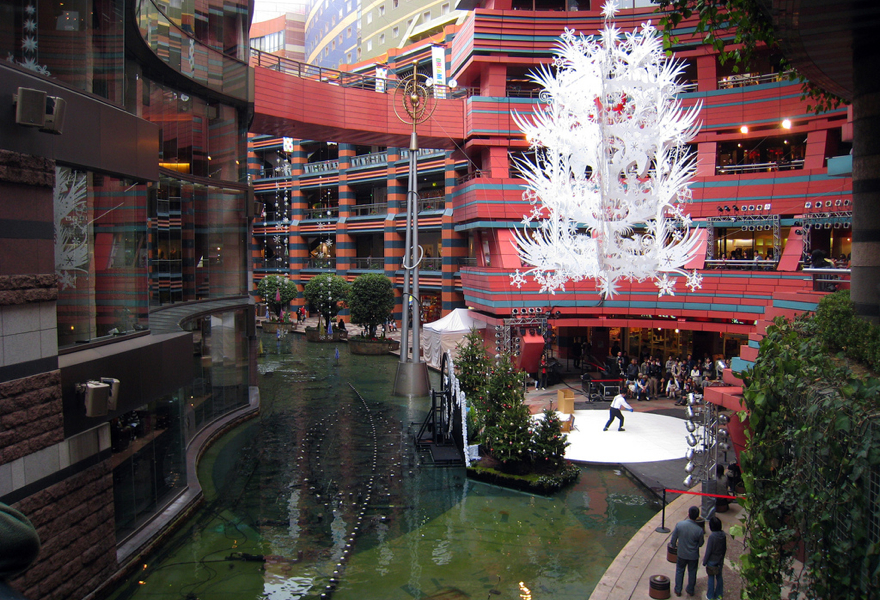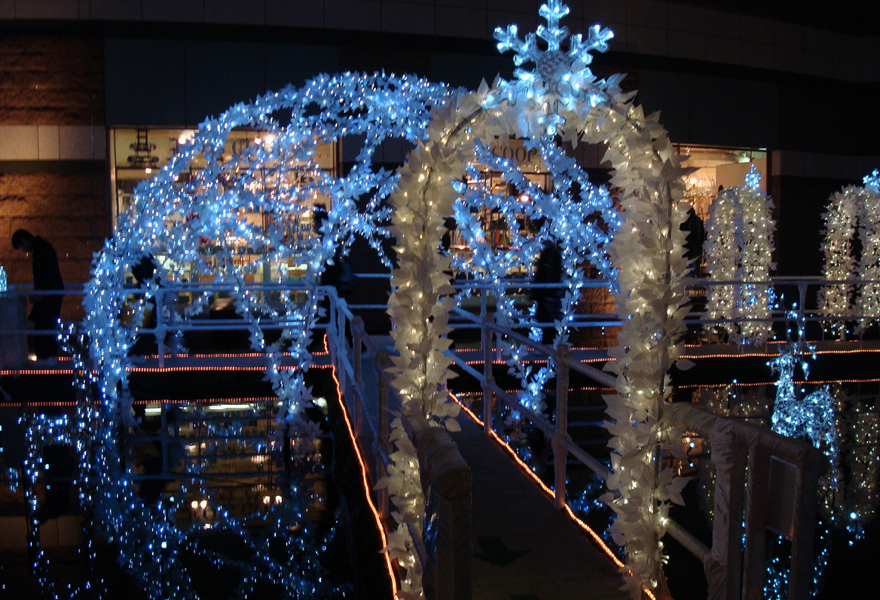The original plan was a day trip to Beppu. A city in Kyushu’s North-East, earmarked for a set of hot springs lovingly labelled “the hells,” each having various intimidating colours, temperatures and alligators. With Setsubun on the way, a festival where people flick soybeans at folks dressed like demons, I expected the Oni cosmetics to be on high. But then it rained. As if Fukuoka was being punished by a different Japanese creature, say a Raijan, a Shinto god of storms, the rain came down. It was the first lightning I had seen in my two-month stay in Japan. The thunderclaps sounded like subway cars derailing. I looked out my window just to check.
On my first night in Kyushu I met up with an animator to drink liquor made of giant hornets in downtown Fukuoka. My walk to meet her was pleasant. A number of rivers made for a chain of waterfronts, lined with lights, statues, portable restaurants that pop open on the sidewalk at night, but I also drifted by this goofy looking mall. Its display board hovering over its UNIQLO sign cycled between stores and shots of dancing fountains. There was a three-legged pop-art frog nesting just outside the entrance.

This was Canal City Hakata, a shopping plaza that ranks high on the tourist tip sites. As a guy who usually can’t be bothered with malls, this seemed like an odd thing to earmark. But I drank my venomous hornet stew the night before, and hell got rained out, so the mall gets a shot.
Here’s an aside. Why did you play Myst? You might have liked its puzzle sensibilities, its lucid dream of a story, but what drew you to it? Myst has an ambiance that strikes you when you see its box. An early-90s CG dreamscape, an island located somewhere in a vision, pantheons drawing from ancient civilizations as much as that uncanny virtual-fetish Beyond The Mind’s Eye vibe that had a pervasive hold on the generation. So maybe you liked certain things within Myst, but likely the reason you came to it, the same testament they encapsulated on its unmistakable cover, is because you wanted to check out this world Myst was advertising.
You wanted to explore this mysterious place.
UNIQLO is not mysterious. I know many places in North America are very excited to get them soon, and the sign is very economical in its design, but it is still a flexible clothing chain and little more. UNIQLO is not mysterious, nor is Cold Stone Creamery nor is Zara nor is Shakey’s Pizza Parlour or the several other stores that lined Canal City’s first corridor. An open-roof, dual-sided, storied corridor, which, as far as fountains go, only had a few pedestrian squirters and, as far as shelter goes, still had puddles forming as rain slid down the canopy of awnings. If only to get out of the weather, I walked to the second building, which is where things became odd. And promising.

Less something I’d expect out of the Toronto-based Eaton Center and more something I’d expect out of the Toronto-based Videodrome, there was a wall of old television sets, scaling up several floors, and many cycling through glitched-out test patterns, like an abandoned Moses-era Much Music prop (like I said, Videodrome-y). The televisions that weren’t showing the frenetic displays were just dead, completely off. This seemed to me to be a good enough sight to see on the rainy-day trip, mall-wise, so I tried to leave. Tried to.
The TV installation was the bug zapper, but the rest of the mall was the roach motel. The thing about Fukuoka is that few streets are parallel, making it a perilous place to get lost. When roads split like hairs at 15 degree angles, taking a wrong turn can throw you way off-course, and quickly. I hoped to leave Canal the same way I entered, but its hostile layering and strange prerogatives to retail space made it a little disorienting. Somehow I ended up on its open side, and Canal decided to show its true colours.
Here was the actual canal of Canal. There were tiered floors, sloping and sinking towards a stream that cut between the retail plazas and a restaurant that shared aesthetics closer with a nice hotel lobby, with a piano sitting on an illuminated platform next to a full wall of glass. The boardwalk was lined with magic stands and caricature artists, like a fairground. Tall cosmic pillars broached the ground, their peaks like orbital clocks. The floors began to create rune-like shapes, the center a handrail-less glaive sitting in the water. The bridges on the ground across the canal were more like stepping-stones, onto which no one seemed enthusiastic to venture when it was so damp out. Parts of the ground spit up tufts of vapour. I’d go so far as to say this mall started to feel like Myst.

The music was this uneasy ambiatic non-song composed of weak hymns and white noises. It sounded like I should be cautious, a soothing but suspicious tune. It was, in fact, not unlike the plucking melodies Robyn Miller put together to keep you on your toes as you explored the island of Myst. Instead, this is a place where people go to buy shirts.
Right in front of the glaive was the fountain of fountains. At least twice an hour, a regiment of water cannons began to dance, shooting geysers stories into the air, tilting from side to side. They were able to spit up loogies of water, coming down as a hard bellyflopped slap, which was coordinated to keep rhythm to Zimmer’s Pirates of the Caribbean theme. It would perform regardless of whether or not there was an audience there to witness it.
And because I didn’t leave Canal City, or couldn’t, here are the stores I saw: A Moomin-themed cafe, where you could prop up dolls of the characters from the cult Finnish cartoon at your table, in case you want to take your loneliness to the next level. A character avenue, a gauntlet of shops themed on franchises like Ultraman, One Piece and Studio Ghibli, a place that screamed “get your gift shopping done here.” The most visually pleasing Disney Store I have ever seen: devoid of character explosions in the window, it went for the ivory elegance of Cinderella’s chariot instead. On the top floor was a “Ramen Stadium,” a nook of guest kitchens of ramen chefs from around the country. Right next to that, I shit you not, an escape-the-room attraction. I think it was run by Taito, or just occupied itself directly across from Taito’s arcade.

I sometimes couldn’t help but envision Canal City as this kind of fortress, one of those apocalypse-lit communes where children chase chickens along the manufactured rivers and dust clouds, the broad sides of the building for outposts and cannon stations. It felt strategically isolated from the rest of the city, if not reality.
But as far as function goes, Canal City was horribly designed. Stores are out of view from each other, usually because they all cling to a single wall; the corridors that do exist are short and blocky. Everything flows into each other but not in a way conducive to knowing where you are. This was all fine because I didn’t really care where I was going, and for all I know the greatest trove I could have unearthed was around a corner I didn’t get to. I didn’t manage to exit through the entrance I came in from. I ended out plopping from one of the flanks, and only found my footing by following signs back to Hakata station. Canal City is a dystopia of whimsy. It doesn’t make sense as a mall, but it would be fine as a playground. It was a game, an environment to explore and conquer. That night I got a pasta dish that somehow took an hour, so the chef could seamlessly stuff baby squid with a sausage and replace its tentacles with spaghetti. It felt like Fukuoka’s final attempt to drive the point home that it doesn’t give a shit about function.
Images via David Lisbona, JoshBerglund19, Tzuhsun Hsu
